Alberto Rech
Department of Information Engineering, University of Padova, Italy
Scheduling for Downlink OFDMA With IRS Reconfiguration Constraints
Jan 05, 2024Abstract:The technical limitations of the intelligent reflecting surface (IRS) (re)configurations in terms of both communication overhead and energy efficiency must be considered when IRSs are used in cellular networks. In this paper, we investigate the downlink time-frequency scheduling of an IRS-assisted multi-user system in the orthogonal frequency-division multiple access (OFDMA) framework wherein both the set of possible IRS configurations and the number of IRS reconfigurations within a time frame are limited. We formulate the sum rate maximization problem as a non-polynomial (NP)-complete generalized multi-knapsack problem. A heuristic greedy algorithm for the joint IRS configuration and time-frequency scheduling is also proposed. Numerical simulations prove the effectiveness of our greedy solution.
Minimum-Latency Scheduling For Partial-Information Multiple Access Schemes
Aug 04, 2023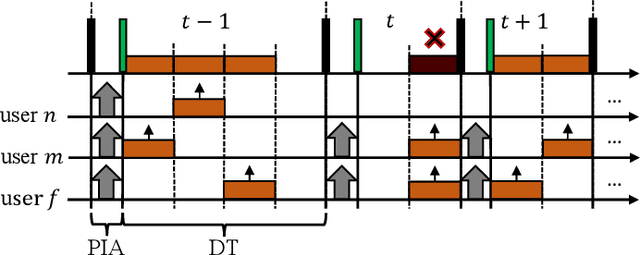
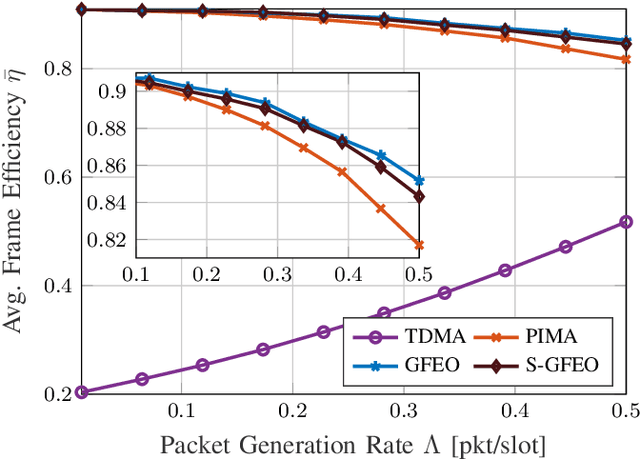
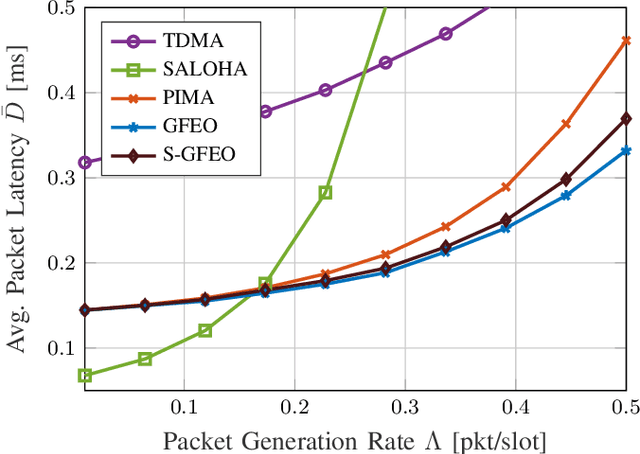
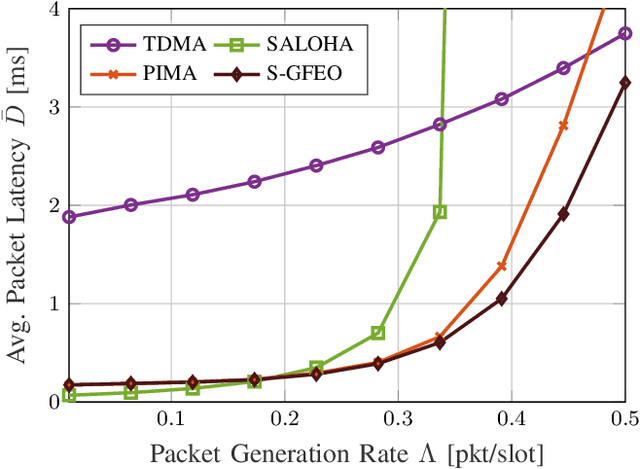
Abstract:Partial-information multiple access (PIMA) is an orthogonal multiple access (OMA) uplink scheme where time is divided into frames, each composed of two parts. The first part is used to count the number of users with packets to transmit, while the second has a variable number of allocated slots, each assigned to multiple users to uplink data transmission. We investigate the case of correlated user activations, wherein the correlation is due to the retransmissions of the collided packets, modeling PIMA as a partially observable-Markov decision process. The assignment of users to slots is optimized based on the knowledge of both the number of active users and past successful transmissions and collisions. The scheduling turns out to be a mixed integer nonlinear programming problem, with a complexity exponentially growing with the number of users. Thus, sub-optimal greedy solutions are proposed and evaluated. Our solutions show substantial performance improvements with respect to both traditional OMA schemes and conventional PIMA.
Semi-Grant-Free Orthogonal Multiple Access with Partial-Information for Short Packet Transmissions
Jul 27, 2023Abstract:Next-generation internet-of-things (IoT) networks require extremely low latency, complexity, and collision probability. We introduce the novel partial-information multiple access (PIMA) scheme, a semi-grant-free (GF) coordinated random access (RA) protocol for short packet transmission, with the aim of reducing the latency and packet loss of traditional multiple access schemes, as well as more recent preamble-based schemes. With PIMA, the base station (BS) acquires partial information on instantaneous traffic conditions in the partial information acquisition (PIA) sub-frame, estimating the number of active devices, i.e., having packets waiting for transmission in their queue. Based on this estimate, the BS chooses both the total number of slots to be allocated in the data transmission (DT) sub-frame and the respective user-to-slot assignment. Although collisions may still occur due to multiple users assigned to the same slot, they are drastically reduced with respect to the slotted ALOHA (SALOHA) scheme, while achieving lower latency than both time-division multiple-access (TDMA) and preamble-based protocols, due to the extremely reduced overhead of the PIA sub-frame. Finally, we analyze and assess the performance of PIMA under various activation statistics, proving the robustness of the proposed solution to the intensity of traffic, also with burst traffic.
Downlink Clustering-Based Scheduling of IRS-Assisted Communications With Reconfiguration Constraints
May 23, 2023Abstract:Intelligent reflecting surfaces (IRSs) are being widely investigated as a potential low-cost and energy-efficient alternative to active relays for improving coverage in next-generation cellular networks. However, technical constraints in the configuration of IRSs should be taken into account in the design of scheduling solutions and the assessment of their performance. To this end, we examine an IRS-assisted time division multiple access (TDMA) cellular network where the reconfiguration of the IRS incurs a communication cost; thus, we aim at limiting the number of reconfigurations over time. Along these lines, we propose a clustering-based heuristic scheduling scheme that maximizes the cell sum capacity, subject to a fixed number of reconfigurations within a TDMA frame. First, the best configuration of each user equipment (UE), in terms of joint beamforming and optimal IRS configuration, is determined using an iterative algorithm. Then, we propose different clustering techniques to divide the UEs into subsets sharing the same sub-optimal IRS configuration, derived through distance- and capacity-based algorithms. Finally, UEs within the same cluster are scheduled accordingly. We provide extensive numerical results for different propagation scenarios, IRS sizes, and phase shifters quantization constraints, showing the effectiveness of our approach in supporting multi-user IRS systems with practical constraints.
Partial-Information Multiple Access Protocol for Orthogonal Transmissions
Apr 24, 2023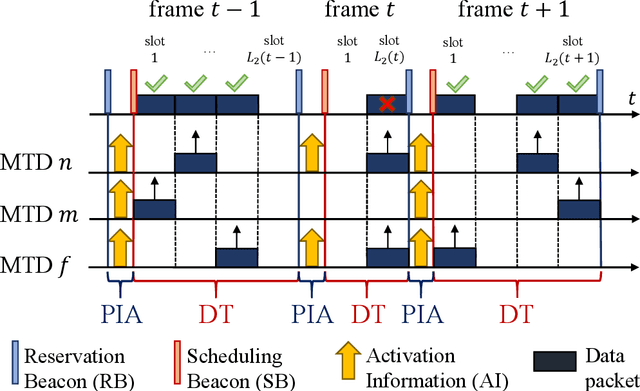
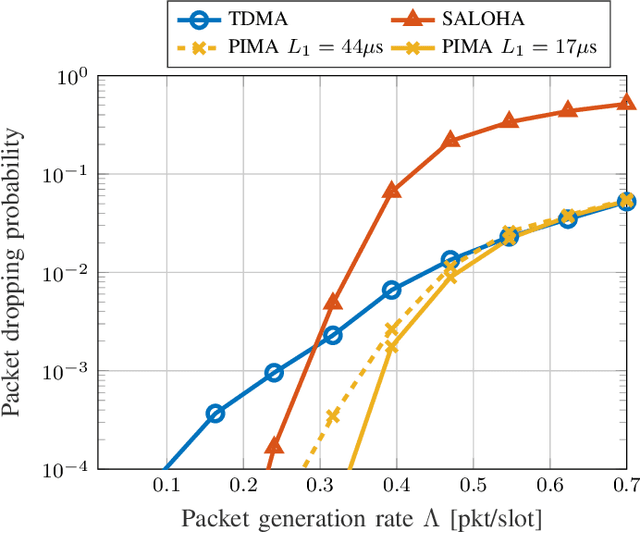
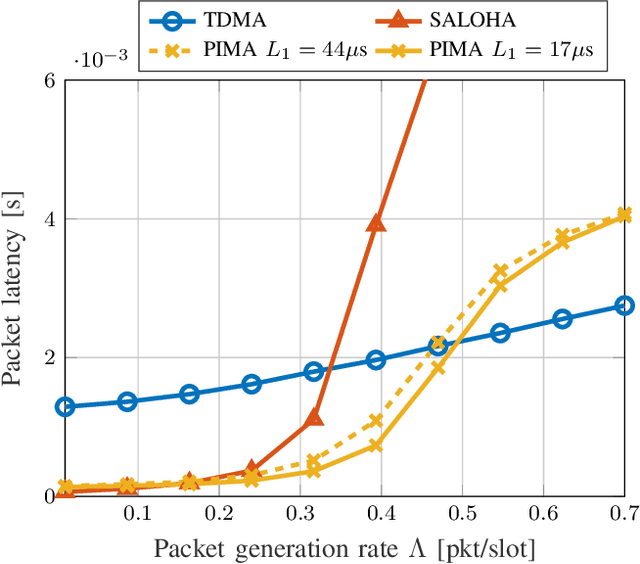
Abstract:With the stringent requirements introduced by the new sixth-generation (6G) internet-of-things (IoT) use cases, traditional approaches to multiple access control have started to show their limitations. A new wave of grant-free (GF) approaches have been therefore proposed as a viable alternative. However, a definitive solution is still to be accomplished. In our work, we propose a new semi-GF coordinated random access (RA) protocol, denoted as partial-information multiple access (PIMA), to reduce packet loss and latency, particularly in the presence of sporadic activations. We consider a machine-type communications (MTC) scenario, wherein devices need to transmit data packets in the uplink to a base station (BS). When using PIMA, the BS can acquire partial information on the instantaneous traffic conditions and, using compute-over-the-air techniques, estimate the number of devices with packets waiting for transmission in their queue. Based on this knowledge, the BS assigns to each device a single slot for transmission. However, since each slot may still be assigned to multiple users, collisions may occur. Both the total number of allocated slots and the user assignments are optimized, based on the estimated number of active users, to reduce collisions and improve the efficiency of the multiple access scheme. To prove the validity of our solution, we compare PIMA to time-division multiple-access (TDMA) and slotted ALOHA (SALOHA) schemes, the ideal solutions for orthogonal multiple access (OMA) in the time domain in the case of low and high traffic conditions, respectively. We show that PIMA is able not only to adapt to different traffic conditions and to provide fewer packet drops regardless of the intensity of packet generations, but also able to merge the advantages of both TDMA and SALOHA schemes, thus providing performance improvements in terms of packet loss probability and latency.
Unsourced Random Access With Tensor-Based and Coherent Modulations
Apr 24, 2023Abstract:Unsourced random access (URA) is a particular form of grant-free uncoordinated random access wherein the users' identities are not associated to specific waveforms at the physical layer. Tensor-based modulation (TBM) has been recently advocated as a promising technique for URA due to its ability to support a large number of active users transmitting simultaneously by exploiting tensor decomposition for user separation. We propose a novel URA scheme that builds upon TBM by splitting the transmit message into two sub-messages. This first part is modulated according to a TBM scheme, while the second is encoded using a coherent non-orthogonal multiple access (NOMA) modulation. At the receiver side, we exploit the advantages of forward error correction (FEC) coding and interference cancellation techniques. We compare the performances of the introduced scheme with state-of-the-art URA schemes under a quasi-static Rayleigh fading model, proving the energy efficiency and the fading robustness of the proposed solution.
Downlink TDMA Scheduling for IRS-aided Communications with Block-Static Constraints
Jan 25, 2023



Abstract:Intelligent reflecting surfaces (IRSs) are being studied as possible low-cost energy-efficient alternatives to active relays, with the goal of solving the coverage issues of millimeter wave (mmWave) and terahertz (THz) network deployments. In the literature, these surfaces are often studied by idealizing their characteristics. Notably, it is often assumed that IRSs can tune with arbitrary frequency the phase-shifts induced by their elements, thanks to a wire-like control channel to the next generation node base (gNB). Instead, in this work we investigate an IRS-aided time division multiple access (TDMA) cellular network, where the reconfiguration of the IRS may entail an energy or communication cost, and we aim at limiting the number of reconfigurations over time. We develop a clustering-based heuristic scheduling, which optimizes the system sum-rate subject to a given number of reconfigurations within the TDMA frame. To such end, we first cluster user equipments (UEs) with a similar optimal IRS configuration. Then, we compute an overall IRS cluster configuration, which can be thus kept constant while scheduling the whole UEs cluster. Numerical results show that our approach is effective in supporting IRSs-aided systems with practical constraints, achieving up to 85% of the throughput obtained by an ideal deployment, while providing a 50% reduction in the number of IRS reconfigurations.
End-to-End Simulation of 5G Networks Assisted by IRS and AF Relays
Mar 04, 2022
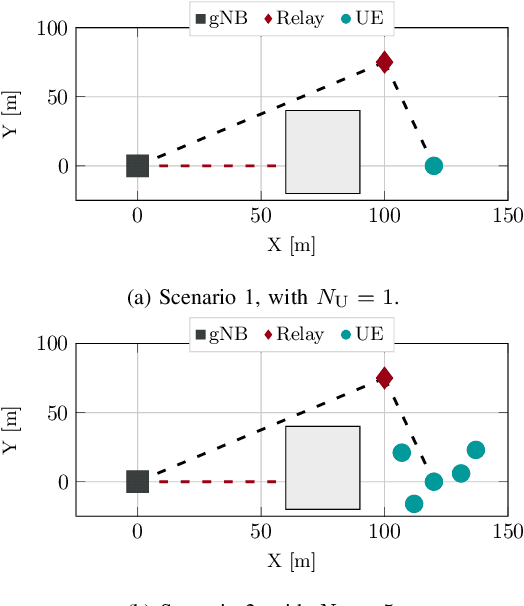

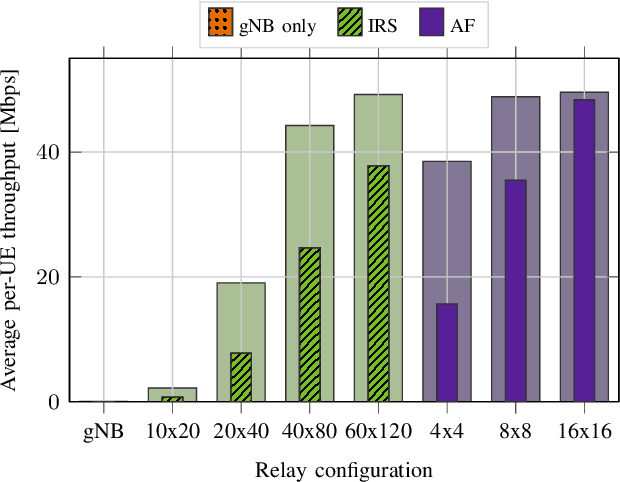
Abstract:The high propagation and penetration loss experienced at millimeter wave (mmWave) frequencies requires ultra-dense deployments of 5th generation (5G) base stations, which may be infeasible and costly for network operators. Integrated Access and Backhaul (IAB) has been proposed to partially address this issue, even though raising concerns in terms of power consumption and scalability. Recently, the research community has been investigating Intelligent Reflective Surfaces (IRSs) and Amplify-and-Forward (AF) relays as more energy-efficient alternatives to solve coverage issues in 5G scenarios. Along these lines, this paper relies on a new simulation framework, based on ns-3, to simulate IRS/AF systems with a full-stack, end-to-end perspective, with considerations on to the impact of the channel model and the protocol stack of 5G NR networks. Our goal is to demonstrate whether these technologies can be used to relay 5G traffic requests and, if so, how to dimension IRS/AF nodes as a function of the number of end users.
Coordinated Random Access for Industrial IoT With Correlated Traffic By Reinforcement-Learning
Sep 17, 2021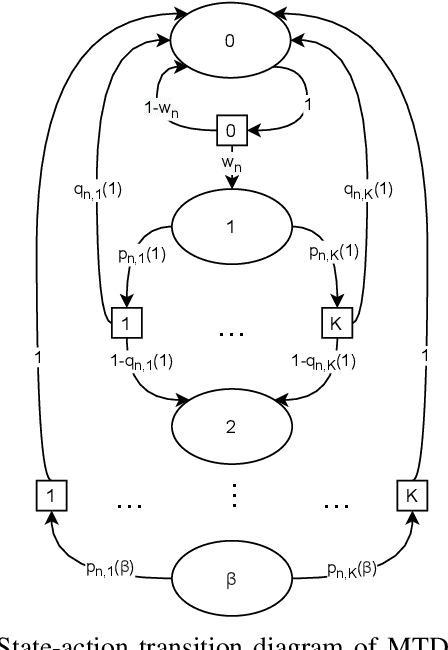
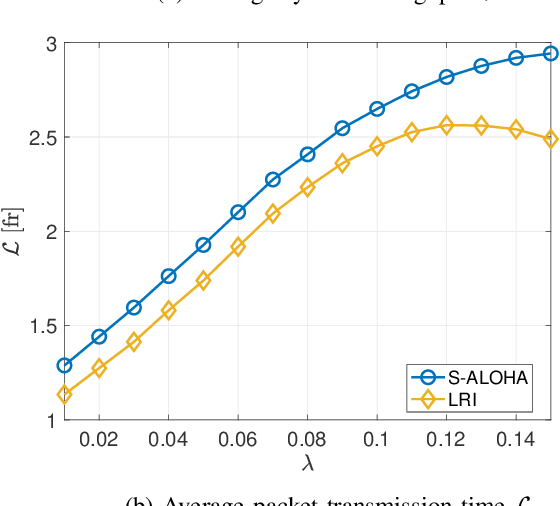
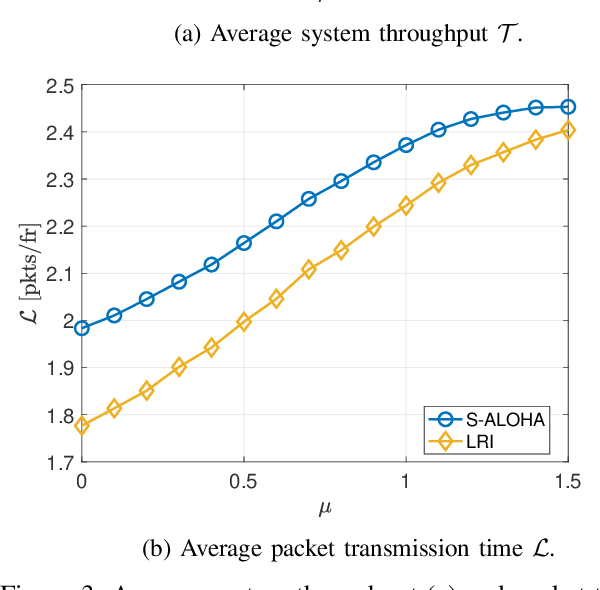
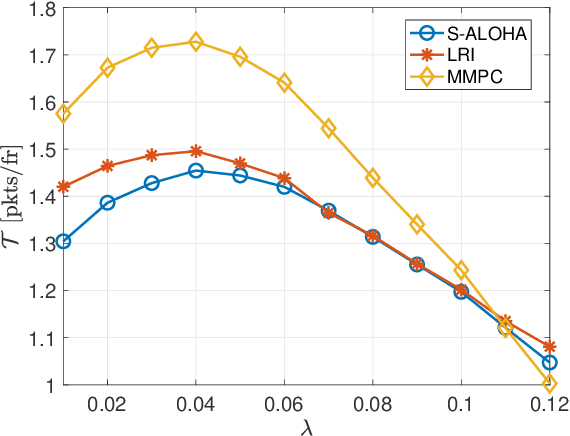
Abstract:We propose a coordinated random access scheme for industrial internet-of-things (IIoT) scenarios, with machine-type devices (MTDs) generating sporadic correlated traffic. This occurs, e.g., when external events trigger data generation at multiple MTDs simultaneously. Time is divided into frames, each split into slots and each MTD randomly selects one slot for (re)transmission, with probability density functions (PDFs) specific of both the MTD and the number of the current retransmission. PDFs are locally optimized to minimize the probability of packet collision. The optimization problem is modeled as a repeated Markov game with incomplete information, and the linear reward-inaction algorithm is used at each MTD, which provably converges to a deterministic (suboptimal) slot assignment. We compare our solution with both the slotted ALOHA and the min-max pairwise correlation random access schemes, showing that our approach achieves a higher network throughput with moderate traffic intensity.
Maximum-Rate Optimization of Hybrid Intelligent Reflective Surface and Relay Systems
Sep 17, 2021



Abstract:We consider a wireless communication system, where a transmitting source is assisted by both a reconfigurable intelligent reflecting surface (IRS) and a decode-and-forward half-duplex relay (hybrid IRS-relay scheme) to communicate with a destination receiver. All devices are equipped with multiple antennas, and transmissions occur in two stages. In stage 1, the source splits the transmit message into two sub-messages, transmitted to the destination and the relay, respectively, using block diagonalization to avoid interference. Both transmissions will benefit from the IRS. In stage 2, the relay re-encodes the received sub-message and forwards it (still through the IRS) to the destination. We optimize power allocations, beamformers, and configurations of the IRS in both stages, in order to maximize the achievable rate at the destination. We compare the proposed hybrid approach with other schemes (with/without relay and IRS), and confirm that high data rate is achieved for the hybrid scheme in case of optimal IRS configurations.
 Add to Chrome
Add to Chrome Add to Firefox
Add to Firefox Add to Edge
Add to Edge